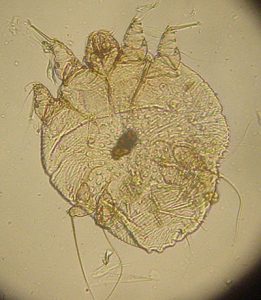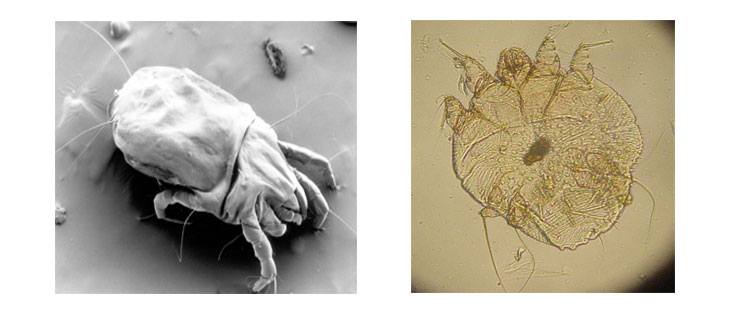Dust Mites vs Scabies: What’s the Difference?
Mites are incredibly numerous species of arthropod that is found virtually everywhere on Earth except for Antarctica. To the dismay of many, mites share all of the places where people live and work.
Of course, most people don’t even know that mites are present, and that includes those times when mites are actually crawling on or otherwise making themselves unwelcome on human bodies.
That’s because many of the most common species of mites are so small that they can only be properly viewed under a microscope.
House dust mites and scabies mites are two examples of microscopic mites that are likely to be found inside human habitations.
Though both are arthropods with eight legs, this is where most of their similarities end. Their behavior, habitat and the effect that they have on people are markedly different from each other.
Contents
What Is a House Dust Mite?

This mite is virtually invisible to the naked eye. Under the microscope, it’s possible to see this arthropod’s translucent body. With an adult size of much less than one millimeter, some people have difficulty believing that the dust mite can wreak so much havoc in households.
However, dust mites, and their waste products, easily can become airborne. Accordingly, they are considered to be among the foremost triggers of asthma and allergy symptoms in all four seasons.
Dust mites may be able to live in just about any conditions, but they thrive when temperatures average between 68 and 77 degrees. They prefer humidity levels of approximately 70 and 80 percent. People and pets provide dust mites with their main source of food: dead skin cells.
The average person sheds some one-and-a-half grams of skin every day. This amount of skin provides sustenance for approximately one million house dust mites.
Dust mites typically don’t live on people or animals. Instead, they work their way into mattresses, bed linens, upholstered furniture, rugs, carpets and stuffed animals because these items typically have a good supply of skin that people have shed.
Mattresses and other items found on or near beds are usually the most highly infested parts of the home.
Symptoms of a Dust Mite Allergy
Dust mites are everywhere, and most people have some level of reaction to their presence. While some people may experience slight nasal congestion, others are afflicted with symptoms that cannot be ignored. The symptoms of dust mite allergy include:
- Itching in the nose, throat and mouth
- Uncontrollable sneezing
- Coughing
- Nasal congestion
- Red, watery, irritated eyes
- Runny nose and postnasal drip
People who have asthma may find that dust mites trigger an attack. These episodes are accompanied by symptoms like:
- Wheezing
- Labored breathing
- Tightness or pain in the chest
An appointment with a doctor, particularly one who specializes in the treatment of allergies, may be necessary to alleviate these and other symptoms.
What Are Scabies Mites?

Rather than infesting mattresses, other furniture and carpets, scabies mites infest people and pets. In fact, scabies frequently are transmitted from one mammal to another through one-on-one contact.
Several types of scabies mites are found around the world. Each species tends to have a preferred host such as dogs, cats or humans. Adults of the species generally are less than half a millimeter long, so they are not visible to the naked eye.
Like dust mites, scabies mites often consume skin. Rarely, they infest mattresses, towels and clothing like dust mites do. Scabies mites prefer to be directly on or in the skin of their host. In fact, they frequently burrow into the outer layers of the host’s skin, where females may lay their eggs.
It sounds like something out of a horror movie, but absolutely anyone can be infested with scabies mites, which also may be referred to as human itch mites.
When someone is newly infected, they may not show any symptoms for two to six weeks. Then, the torment becomes unbearable.
The Symptoms of Scabies
Human itch mites cause a condition called “scabies” in people. The most troubling and annoying symptom of this condition is the itching, which tends to become particularly intense at night. Accordingly, having scabies can make getting a good night’s sleep incredibly difficult.
Many people also notice a red, raised rash that accompanies the itch. Some people mistake the rash for pimples or hives. In some people, the rash more closely resembles a break out of eczema.
Sores and crusts on the skin are other symptoms. Excessive itching often goes with all of these scabies symptoms. All that itching damages the skin, causing it to break and bleed. This makes an infection likely. Getting prompt medical attention is vital in this situation.
Protecting Yourself From Mites
It is impossible to live a life that is totally free of mites. These microscopic creatures are everywhere, and having them does not mean that your home is unclean.
Nonetheless, you can do many things that will protect you and your family from suffering the allergic reactions that often accompany dust mites and scabies mites.
Regular vacuuming is critical to ridding your home of excess mites, the bodies of dead mites and their waste products.
If at all possible, choose flooring materials like wood, vinyl and tile, avoiding wall-to-wall carpet, which is notorious for harboring dust mites.
Frequently wash sheets, bed linens and towels in hot water. As long as the water reaches a minimum of 130 degrees, it should kill most of the mites. You might consider purchasing dust-proof covers for mattresses and pillows.
Mites cannot burrow through these covers, which gives you a good chance of limiting your exposure to allergens.
If you suspect that you or a loved one has scabies, don’t delay seeking treatment from a dermatologist. The sooner you are diagnosed, the sooner the treatment will take effect and the less severe the symptoms are likely to be. Follow the doctor’s advice to the letter, and you’ll soon experience relief.

